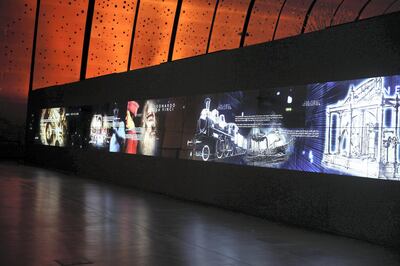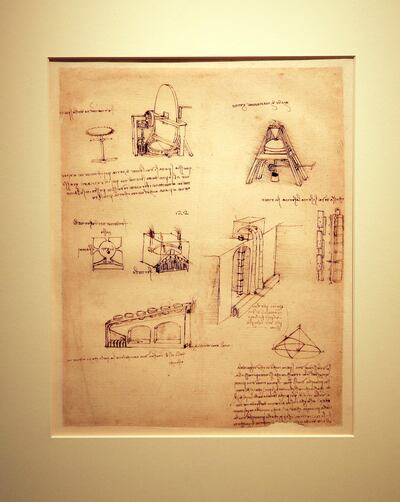The intersection between past and present, culture and knowledge, is being highlighted in a new exhibition in Saudi Arabia. It showcases works by Leonardo da Vinci and contemporary Swiss architect Philippe Rahm, exploring the theme of energy through the lens of history.
In the Great Hall of the King Abdulaziz Centre for World Culture (Ithra), a pair of five-metre spheres hang from the ceiling. The impressive sculptures represent the Sun and the Moon, and were specially designed by Rahm in France, custom-made by Atlas Exhibitions in Dubai, and then flown to Ithra in Dammam, where the exhibition Leonardo da Vinci: Codex Through Space and Time will be held until April 14.
Nearby, and encased in temperature-controlled, glass-fronted cabinets, are six sheets from Leonardo's Codex Atlanticus, the polymath's 12-volume, 1,119-page, bound set of drawings and writings that is on loan from the Biblioteca Ambrosiana of Milan, with the support of the Italian Ministry of Cultural Heritage and Activities and the Pontifical Council for Culture.
The exhibition takes visitors through a journey of 1,400 years and emphasises how the wisdom of Arab scholars in the Islamic Golden Age inspired Leonardo, which in turn informed today's advanced theories of energy and sustainability, a subject in which Rahm excels.
The exhibition's importance
To illustrate this, the chosen papers, which had never before left Italy, all demonstrate Leonardo's study of instruments and tools related to fire and water – two opposing elements. This theme is developed further by Rahm's sun and moon, which feature 240 spokes fitted with specially created light bulbs that dim every couple of minutes according to our day-to-night cycle. A light and airy sound emanates from built-in speakers to mark sundown, while an intense noise that signifies the explosion of energy announces sunrise. A 20-metre, 30-screen video wall has been built to tie it all together, with content curated by Italian company 360FX that tells these three intersecting stories, taking us seamlessly from ancient Arabia through Renaissance Italy to the present.

"There's a double layer of importance to this exhibition," says Benedetta Torino, chief executive of NSPRD, the Italian museums management and exhibition production company that is behind the showcase. "There's an important international exchange in terms of pieces of art from Italy, showing for the first time in Saudi Arabia. On the other hand, Philippe created a specific work for the space and for Ithra, and this is in dialogue with one of the most important artists in the world."
'Science creates an agreement between people'
The exhibition also commemorates the 500th anniversary of Leonardo's death. Italian curator Marcello Smarrelli says that, among the hundreds of events being held across the world to mark the occasion, this one stands out for its "original and surprising approach, between the infinite possibility of ideas that the work and the human story of artists suggest".
It does this through a merging of classical approaches to art and science, with a more modern outlook through Rahm’s paradigm. “In my career as a curator, I have found that very often the public of classical art is very critical of contemporary art,” Smarrelli explains. “But I stole the motto of a great Italian contemporary artist, Maurizio Nannucci, who says: ‘All art has been contemporary.’ Every artist of every age has been a contemporary of someone. I think that artists and art of all times can always talk to each other.”
Similar to how work by the Islamic scholars influenced Leonardo, the Italian's way of researching and inventing inspires Rahm to this day. The artist says he believes the Renaissance era and the rising interest in science at the time was a crucial turning point for Europe. "It was a good period, after a long war, to bring back something objective, and to go beyond the subjectivity of all the different people," he says. "Science creates an agreement between people."
A new way of designing
In the exhibition, Rahm, through his sculptures, has tried to depict two different types of energy that bridge the gap between the 20th and 21st centuries, highlighting the need to move from using fossil fuels to renewable power. "My work focuses on energy, sustainability and fighting climate change," he says. "Not just because this is something we have to talk about today – of course we do – but because architecture is linked. Architects are on the front line of fighting global warming.

"Also, architecture is about climate. Why? We build houses because there is too much sun and you have to create shadow. Or there is too much wind and you have to create a wall … everywhere in the world, architecture is there to change the climate, to create a more comfortable climate. This is the original mission of architecture."
And that's why, Rahm says, architects urgently need to find a new way of designing. These are all hot-topic issues that the world is waking up to, and the best way to spread any message is through art, says Torino. "Art talks to everybody – it goes straight to the heart of the people," she says. "It's an international language that you simply live and feel. There's no border in art."
Inspiring visitors with original work
In this context, bringing together the works of Arabia and Europe makes perfect sense, and it works with Ithra's main strategy of cross-cultural co-operation, says Fatmah Al Rashid, the centre's acting director. "The experiences we seek to provide help raise cultural awareness, stimulate knowledge and promote local and international talent in Saudi Arabia and beyond," she tells The National.
"The kingdom is currently undergoing a crucial transformation in its cultural landscape, spearheaded by Saudi talent, where creativity and innovation is at the forefront of the country's future – ideals championed by Leonardo himself. By bringing his sketches to the region for the first time, we aim to continue inspiring our visitors by exposing them to original work by an original visionary."
Rahm says this kind of cross-cultural exchange is the only way for civilisations to move out of their comfort zones. "It's very important to share art because it shows that, when you stay in your own limits and own border, you are losing the capacity to compare, to be critical with what you're doing," he says. "Art gives you the knowledge, the tool for understanding that maybe what you think is not the right thing; you can be challenged by something else."
Ultimately, Smarrelli hopes to unite people through the exhibition. "I'm sure it will strengthen the bridge between East and West, between past and present, because culture and art create peace and friendship between people."
That, Torino adds, is more important now than ever. "Our aim is not just to do it from time to time but to build a durable collaboration in terms of cultural content that brings the two civilisations together. That would be a dream."
What is the 'Codex Atlanticus'?
The Codex Atlanticus is 12 volumes of drawings and writings by Leonardo da Vinci spread across 1,119 pages, many of which are drawn or written on both sides of the paper. It is the largest collection of original papers by the celebrated polymath and was assembled towards the end of the 16th century by Milanese sculptor Pompeo Leoni, who was gathering a significant number of Leonardo's pages.

The binding is inscribed with the words “drawings of machines and of the arts, secrets and other things of Leonardo da Vinci”. The collection gets its name from the large sheets of paper used in atlases, and it is usually kept at Milan’s Biblioteca Ambrosiana. It essentially covers Leonardo’s entire career, with work spanning from 1478, when he worked in Tuscany, until his death in France in 1519.
Leonardo lived during the Renaissance period, and was an engineer, artist, scientist and inventor, whose work focused on subjects such as astronomy, engineering, cartography, painting, music and botany. Inventions such as parachutes and hydraulic pumps can be found in the Codex Atlanticus. It even contains Leonardo's urban planning ideas for Milan, as well as short stories. Above all, it demonstrates the diversity of his contributions to society. It also features names of famous Arab philosophers, mathematicians and scientists, who were said to have inspired Leonardo.
Leonardo da Vinci: Codex Through Space and Time is at the King Abdulaziz Centre for World Culture in Dammam until April 14











